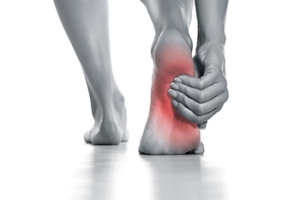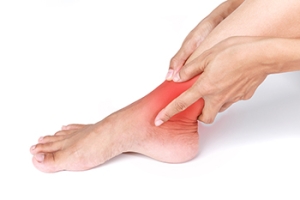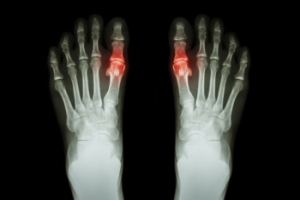
Ankle Pain
Pain experienced in the ankle can be caused by a multitude of conditions. While the most common cause is an ankle sprain, other possible problems can include arthritis, gout, ankle instability, an ankle fracture, nerve compression, or tendinitis. In more serious cases, ankle pain can be a sign of improper alignment of the foot or an infection.
Ankle pain can often be accompanied by symptoms such as redness, swelling, stiffness, and warmth in the affected area. Pain can be described differently depending on the condition: short, stabbing pain and a dull ache are some examples. If such symptoms are persistent and do not improve after time, be sure to schedule an appointment with your local podiatrist.
Depending on the condition causing your ankle pain, different treatments may be prescribed by your podiatrist. For ankle sprains, the first step in treatment involves rest, ice, elevation, and compression. Be sure to avoid placing pressure on the ankle, use an ice pack several times a day, and use a compression bandage and elevation to reduce swelling. Other, more serious conditions may require the assistance of certain drugs and medications such as nonsteroidal anti-inflammatory drugs (NSAIDs), physical therapy, or even cortisone injections.
Depending on the severity of your ankle pain and the condition behind it, recovery from ankle pain may take some time.
Consult with your foot and ankle doctor to best determine the cause of your ankle pain and the appropriate treatment.
Why Shoes Can Make Heels Hurt and How to Prevent It
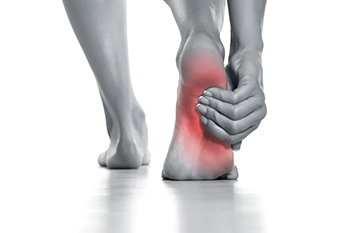
Wearing the wrong shoes can cause heel pain due to poor arch support, insufficient cushioning, or an improper fit. High heels or shoes with a rigid sole can strain the plantar fascia, the ligament connecting the heel to the toes, leading to discomfort. Shoes that are too tight or too loose can also cause friction and pressure points, resulting in heel pain. To prevent this, choose shoes with proper arch support and ample cushioning to absorb impact. Ensuring a correct fit is vital, as shoes should have enough room for your toes and provide a secure fit at the heel. Opt for shoes with a slightly raised heel and a flexible sole to support natural foot movement. These measures can alleviate heel pain and promote overall foot health. If you have heel pain that could be a result of wearing shoes that do not fit right, it is suggested that you consult a podiatrist who can offer you treatment solutions, and guide you toward wearing the right shoes.
Many people suffer from bouts of heel pain. For more information, contact one of our doctors of Favor Foot Ankle Leg & Wound Center. Our doctors can provide the care you need to keep you pain-free and on your feet.
Causes of Heel Pain
Heel pain is often associated with plantar fasciitis. The plantar fascia is a band of tissues that extends along the bottom of the foot. A rip or tear in this ligament can cause inflammation of the tissue.
Achilles tendonitis is another cause of heel pain. Inflammation of the Achilles tendon will cause pain from fractures and muscle tearing. Lack of flexibility is also another symptom.
Heel spurs are another cause of pain. When the tissues of the plantar fascia undergo a great deal of stress, it can lead to ligament separation from the heel bone, causing heel spurs.
Why Might Heel Pain Occur?
- Wearing ill-fitting shoes
- Wearing non-supportive shoes
- Weight change
- Excessive running
Treatments
Heel pain should be treated as soon as possible for immediate results. Keeping your feet in a stress-free environment will help. If you suffer from Achilles tendonitis or plantar fasciitis, applying ice will reduce the swelling. Stretching before an exercise like running will help the muscles. Using all these tips will help make heel pain a condition of the past.
If you have any questions please contact our office located in South Amboy, NJ . We offer the newest diagnostic and treatment technologies for all your foot and ankle needs.
Heel Pain
Heel pain can be difficult to deal with, especially if you do not know what the underlying cause is. If you ignore your heel pain, the pain can magnify and potentially develop into a chronic condition. Depending on the location of your heel pain, you have developed a specific condition.
One condition is plantar fasciitis. Plantar fasciitis is caused by the inflammation of the plantar fascia, or the band of tissue that connects the heel bone to the base of the toes. The pain from this condition is initially mild but can intensify as more steps are taken when you wake up in the morning. To treat this condition, medication will likely be necessary. Plantar fasciitis is often associated with heel spurs; both require rest and special stretching exercises.
There are various options your podiatrist may suggest for heel pain. Treatment options for heel pain typically include non-steroidal anti-inflammatory drugs (NSAIDS), which may reduce swelling and pain. Other options are physical therapy, athletic taping, and orthotics. In severe cases of heel pain, surgery may be required.
Preventing heel pain is possible. If you are looking to prevent heel pain from developing in the future, be sure to wear shoes that fit you properly and do not have worn down heels or soles. Be sure to warm up properly before participating in strenuous activities or sports that place a lot of a stress on the heels. If you are experiencing any form of heel pain, speak with your podiatrist to determine the underlying cause and receive the treatment you need.
Symptoms of a Sprained Ankle
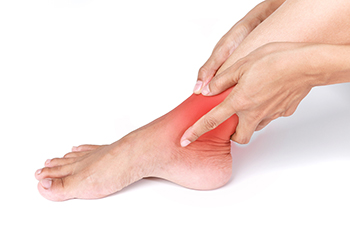 A sprained ankle occurs when the ligaments that support the ankle stretch or tear due to sudden twisting, rolling, or turning of the foot. This injury is common in sports, walking on uneven surfaces, or missteps that put the ankle in an awkward position. Symptoms of a sprained ankle can include pain, swelling, bruising, and difficulty bearing weight on the affected foot. You might also hear a popping sound at the time of the injury. To determine if you have a sprain, pay attention to the severity of pain and swelling, any instability in the ankle, and whether the pain worsens with movement. Initial treatment for a sprained ankle involves rest, compression, and elevation. Avoid putting weight on the ankle and consider using crutches. Anti-inflammatory pain relievers can help manage pain and discomfort. Proper rehabilitation, including targeted stretching exercises, is essential for healing and preventing future injuries. If you think you have sprained your ankle, it is suggested that you schedule an appointment with a podiatrist for an accurate diagnosis and comprehensive treatment plan.
A sprained ankle occurs when the ligaments that support the ankle stretch or tear due to sudden twisting, rolling, or turning of the foot. This injury is common in sports, walking on uneven surfaces, or missteps that put the ankle in an awkward position. Symptoms of a sprained ankle can include pain, swelling, bruising, and difficulty bearing weight on the affected foot. You might also hear a popping sound at the time of the injury. To determine if you have a sprain, pay attention to the severity of pain and swelling, any instability in the ankle, and whether the pain worsens with movement. Initial treatment for a sprained ankle involves rest, compression, and elevation. Avoid putting weight on the ankle and consider using crutches. Anti-inflammatory pain relievers can help manage pain and discomfort. Proper rehabilitation, including targeted stretching exercises, is essential for healing and preventing future injuries. If you think you have sprained your ankle, it is suggested that you schedule an appointment with a podiatrist for an accurate diagnosis and comprehensive treatment plan.
Ankle and foot injuries are common among athletes and in many sports. They can be caused by several problems and may be potentially serious. If you are feeling pain or think you were injured in a sporting event or when exercising, consult with one of our doctors from Favor Foot Ankle Leg & Wound Center. Our doctors will assess your condition and provide you with quality foot and ankle treatment.
Common Injuries
The most common injuries that occur in sporting activities include:
- Achilles Tendonitis
- Achilles Tendon Rupture
- Ankle Sprains
- Broken Foot
- Plantar Fasciitis
- Stress Fractures
- Turf Toe
Symptoms
Symptoms vary depending upon the injury and in some cases, there may be no symptoms at all. However, in most cases, some form of symptom is experienced. Pain, aching, burning, bruising, tenderness, tightness or stiffness, sensation loss, difficulty moving, and swelling are the most common symptoms.
Treatment
Just as symptoms vary depending upon the injury, so do treatment options. A common treatment method is known as the RICE method. This method involves rest, applying ice, compression and elevating the afflicted foot or ankle. If the injury appears to be more serious, surgery might be required, such as arthroscopic or reconstructive surgery. Lastly, rehabilitation or therapy might be needed to gain full functionality in the afflicted area. Any discomfort experienced by an athlete must be evaluated by a licensed, reputable medical professional.
If you have any questions, please feel free to contact our office located in South Amboy, NJ . We offer the newest diagnostic and treatment technologies for all your foot care needs.
Sports Related Foot and Ankle Injuries
Foot and ankle injuries are common among athletes and those who exercise frequently. Most of these injuries are non-life-threatening and can heal in weeks with proper treatment and care. Serious injuries, however, require urgent medical treatment.
Common minor injuries include ankle sprains, ankle strains, Achilles tendonitis, plantar fasciitis, stress fractures, and turf toe. An ankle sprain is when the ligaments in the ankle have either become stretched or torn. When the muscle or tendon is stretched or torn, it is an ankle strain. When the big toe is sprained, it is known as turf toe. Achilles tendonitis is the overuse and inflammation of the Achilles tendon. Plantar fasciitis is the inflammation of the plantar fascia and generally occurs from overuse in athletics. Stress fractures are also caused from overuse and are small cracks in the bone.
Achilles tendon ruptures are common, but more serious. This injury occurs when the Achilles tendon, the largest tendon in the body, ruptures. In most cases, this causes severe pain and difficulty walking; some who have experienced this injury have reported, however, no signs or symptoms. A laceration is a deep cut that can occur anywhere on the body. Lacerations on the foot are rarer, but can occur from things like metal cleats landing on the foot.
Treatment options cover a wide range of methods based upon the injury and its severity. Conditions like plantar fasciitis, stress fractures, Achilles tendonitis, turf toe and ankle sprains/ strains can heal on their own without immediate medical care, but seeing a podiatrist to monitor the injury is always recommended. Following the RICE (Rest, Icing, Compression, and Elevation) protocol is generally enough to treat minor injuries. This means resting the foot by either keeping pressure off the foot or not walking at all. Icing the injury will help reduce swelling and pain. Compressing the wound with a wrap will immobilize and help promote healing. Finally, keeping the wound elevated will also reduce swelling and also help the healing process.
It is important to note that even minor injuries can vary in severity, with grade one being a minor injury and grade three requiring urgent care by a podiatrist. Achilles tendon ruptures and lacerations on the foot generally require urgent medical care and treatment options that need a podiatrist. These could include imaging tests, stitches for cuts, rehabilitation, and casts or braces. Every case is different, however, so it is always recommended to see a podiatrist when pain in the foot does not disappear.
Understanding Pediatric Gout

Pediatric gout, although rare, is a form of arthritis that affects children and is characterized by the accumulation of uric acid crystals in the joints. This condition can cause sudden and severe pain, swelling, redness, and warmth in the affected joints, most commonly the big toe. Symptoms may also include fever and limited joint movement due to intense discomfort. Risk factors for pediatric gout include genetic predisposition, obesity, and certain medications. Medical conditions that affect uric acid metabolism, such as leukemia or kidney disease, are other risk factors. Early diagnosis is essential for effective management, which typically involves medication to reduce uric acid levels and inflammation, along with lifestyle modifications like a balanced diet and maintaining a healthy weight. If your child has periodic, but intense, toe or foot pain, it is strongly suggested that you consult a podiatrist who can accurately diagnose, treat, and manage gout.
Gout is a foot condition that requires certain treatment and care. If you are seeking treatment, contact one of our doctors from Favor Foot Ankle Leg & Wound Center. Our doctors will treat your foot and ankle needs.
What Is Gout?
Gout is a type of arthritis caused by a buildup of uric acid in the bloodstream. It often develops in the foot, especially the big toe area, although it can manifest in other parts of the body as well. Gout can make walking and standing very painful and is especially common in diabetics and the obese.
People typically get gout because of a poor diet. Genetic predisposition is also a factor. The children of parents who have had gout frequently have a chance of developing it themselves.
Gout can easily be identified by redness and inflammation of the big toe and the surrounding areas of the foot. Other symptoms include extreme fatigue, joint pain, and running high fevers. Sometimes corticosteroid drugs can be prescribed to treat gout, but the best way to combat this disease is to get more exercise and eat a better diet.
If you have any questions please feel free to contact our office located in South Amboy, NJ . We offer the newest diagnostic and treatment technologies for all your foot and ankle needs.
Gout
Gout is a form of arthritis that is caused by a buildup of uric acid crystals in the joints. This considered to be one of the most frequently recorded medical illnesses throughout history. Gout occurrences in the US have risen within the past twenty years and the condition now affects 8.3 million people which is 4% of all Americans. Researchers have found that gout affects men more than women and African-American men more than white men.
Symptoms of gout are warmth, swelling, discoloration, and tenderness in the affected joint area. The small joint on the big toe is the most common place for a gout attack to occur.
People who are obese, gain weight excessively, drink alcohol heavily, have high blood pressure, or have abnormal kidney function are more likely to develop gout. Furthermore, certain drugs and diseases are likely to increase levels of uric acid in the joints which eventually leads to gout. You are also more likely to develop gout if you eat a lot of meat and fish.
Many who experience gout attacks will experience repeated attacks over the years. Some people who have gout symptoms, may never have them again, but others may experience them several times a year. If you have gout symptoms throughout the year, you may have recurrent gout. Those who have gout should also be careful about their urate crystals collecting in their urinary tract, because this may lead to kidney stones.
Diagnosis for gout is done by checking the level of uric acid in the joints and blood. Your podiatrist may also prescribe medicine to reduce uric acid buildup in the blood, which will help prevent any gout attacks.
To treat gout, your podiatrist may also prescribe you Anti-inflammatory medication (NSAIDs) which will relieve the pain and swelling of a gout episode and it can also shorten a gout attack. Maintaining a healthy diet is also a proven method to prevent gout attacks.
Benefits of Limb Salvage Surgery
 Limb salvage surgery is a critical procedure used to avoid foot or toe amputation due to severe injuries, infections, or cancers. During the surgery, doctors remove the damaged or diseased parts of the foot while preserving as much healthy tissue as possible. This requires advanced reconstruction techniques to keep the foot functional. Limb salvage surgery helps patients maintain physical abilities and provides significant emotional benefits to enhance the overall quality of their lives. Complex Infections, such as osteomyelitis, can destroy bone and surrounding tissue, requiring careful surgical intervention. Additionally, conditions like bone cancers, severe diabetic ulcers, and peripheral artery disease can severely impair blood flow and tissue health, making limb salvage surgery necessary to prevent amputation. If you or someone you know struggles with severe trauma, infections, bone cancers, diabetic ulcers, or poor circulation affecting your feet, it is suggested you make an appointment with a podiatrist for evaluation and treatment options.
Limb salvage surgery is a critical procedure used to avoid foot or toe amputation due to severe injuries, infections, or cancers. During the surgery, doctors remove the damaged or diseased parts of the foot while preserving as much healthy tissue as possible. This requires advanced reconstruction techniques to keep the foot functional. Limb salvage surgery helps patients maintain physical abilities and provides significant emotional benefits to enhance the overall quality of their lives. Complex Infections, such as osteomyelitis, can destroy bone and surrounding tissue, requiring careful surgical intervention. Additionally, conditions like bone cancers, severe diabetic ulcers, and peripheral artery disease can severely impair blood flow and tissue health, making limb salvage surgery necessary to prevent amputation. If you or someone you know struggles with severe trauma, infections, bone cancers, diabetic ulcers, or poor circulation affecting your feet, it is suggested you make an appointment with a podiatrist for evaluation and treatment options.
Limb salvage can be an effective way in preventing the need for limb amputation. If you have diabetes, cancer, or any other condition that could lead to foot amputation if left unchecked, consult with one of our doctors from Favor Foot Ankle Leg & Wound Center. Our doctors will assess your condition and provide you with quality foot and ankle treatment.
What Is Limb Salvage?
Limb salvage is the attempt of saving a limb, such as the foot from amputation. Podiatrists also try to make sure that there is enough function in the foot after the salvage that it is still usable. Diabetes is the number one cause of non-traumatic amputations in the United States. Those with diabetes experience poor blood circulation, which prevents proper healing of an ulcer. If the ulcer is left uncheck, it could become infected, which could result in the need for amputation.
However, there are other causes as well, such as cancer and traumatic injury. Links between higher mortality rates and amputation have been found. This translates into higher healthcare costs, and a reduced quality of life and mobility for amputees. Podiatrists have attempted to increase the prevalence of limb salvage in an attempt to solve these issues.
Diagnosis and Treatment
Limb salvage teams have grown in recent years that utilize a number of different treatments to save the infected limb. This includes podiatrists that specialize in wound care, rehabilitation, orthotics, and surgery. Through a combination of these methods, limb salvage has been found to be an effective treatment for infected limbs, and as an alternative to amputation. Podiatrists will first evaluate the potential for limb salvage and determine if the limb can be saved or must be amputated.
If you have any questions, please feel free to contact our office located in South Amboy, NJ . We offer the newest diagnostic and treatment technologies for all your foot care needs.
Limb Salvage
Limb salvage is a procedure that involves saving a lower extremity from amputation. In podiatry, limb amputation often occurs as a result of diabetes, peripheral vascular disease, neuropathy, cancer, and severe crush injury. The fundamental goal of limb salvage is to restore and maintain stability and movement of the affected lower extremity.
The procedure typically involves removing the diseased tissue and a small portion of the surrounding healthy tissue, as well as the removal of any affected bone if necessary. If the bone is removed, it is then replaced with prostheses, synthetic metal rods or plates, or grafts from either the patient’s body or a donor. Limb salvage is typically the preferred choice of procedure over amputation, as the procedure preserves both the patient’s appearance and allows for the greatest possible degree of function in the affected limb.
Upon diagnosis and determining that limb salvage is the appropriate treatment, the podiatrist may enlist the help of a physical and/or occupational therapist to prepare the patient for surgery by introducing various muscle-strengthening, walking, and range of motion exercises. Such exercises may be continued as rehabilitation post-procedure.
